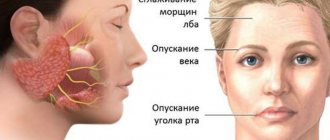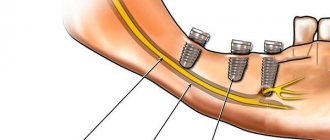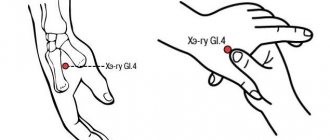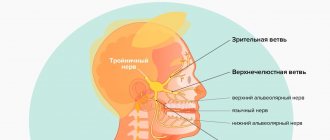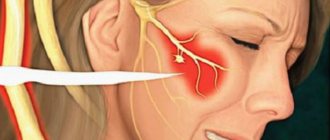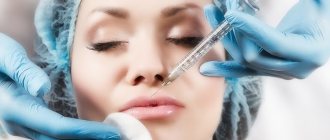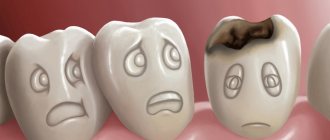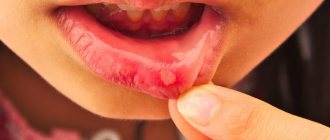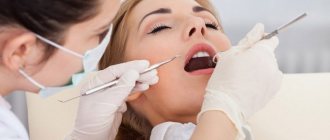September 23, 2021
Trigeminal neuralgia (facial or trigeminal neuralgia) is a disease of the peripheral nervous system characterized by short-term, intense and repeated pain in the area of innervation of one or more branches of the nerve.
Trigeminal neuralgia (facial or trigeminal neuralgia) is a disease of the peripheral nervous system characterized by short-term, intense and repeated pain in the area of innervation of one or more branches of the nerve. The nerve received its name due to the presence of three branches in it: ophthalmic (upper), maxillary (middle), mandibular (lower).
It is extremely difficult to independently diagnose pathology due to the nonspecific symptoms inherent in many diseases (for example, dental ones). That is why, if any unpleasant sensations occur in the facial area, it is necessary to promptly contact a neurologist. Trigeminal neuralgia most often affects adults, especially the elderly, and is more common in women.
The pathogenesis is not completely clear. It is currently believed that the disease occurs as a result of compression of the trigeminal nerve (at the site of its exit from the pons) by tortuous, pathologically altered vessels or, less commonly, by a tumor. As a result of compression, the nerve root adjacent to the cerebral pons undergoes demyelination. This reason explains up to 80-90% of cases of the disease. Rarely, patients with multiple sclerosis develop a plaque in the area of the sensory nucleus of the trigeminal nerve, which leads to neuralgia.
The factors that most often provoke the development of the disease include: pinching of the trigeminal nerve (temporomandibular joint injuries, congenital anomalies in the development of bone structures of the skull, tumors of the brain and facial area, pathological vasodilatation, etc.); viral nerve damage (herpetic infection, polio); odontogenic infections (“unsuccessful” filling or extraction of teeth or other surgical interventions in the face and oral cavity, reaction to anesthesia of dental canals, dental flux).
Symptoms of trigeminal neuralgia
Pain is noted in the area of innervation of one or more sensory branches of the trigeminal nerve, most often the maxillary. The pain is paroxysmal, lasting from a few seconds to 2 minutes, but attacks can quickly recur. The pain is shooting, excruciating, often disabling, and is often triggered by touching trigger points on the face or movements (for example, chewing, brushing teeth, or smiling). Often the patient cannot sleep on the affected side of the face; on average, the attack lasts up to 3 minutes; in about 7% of patients it lasts up to 3 days. Their number can reach 200 per day.
Over time, the pain progresses and may be constant, without intervals. The effectiveness of medications that relieve pain decreases and the patient can no longer control the pain. It becomes exhausting for him. Patients may withdraw from social contacts and daily activities for fear of pain returning.
Pain from trigeminal neuralgia can be observed in different parts of the face. It all depends on which branch of the nerve was affected, if the maxillary - in the area of the facial muscles, upper jaw and nose, the mandibular - the pain will resemble a toothache, the ocular - in the area of the temples, forehead and above the eyebrows. Other characteristic symptoms of inflammation of the trigeminal nerve: spasms of the facial muscles; increased salivation; increased or decreased sensitivity of facial skin; moderate increase in temperature; weakness and muscle pain.
Massage technique for different areas
Depending on the area where the massage is performed, the massage technique may vary and include a certain set of actions. A general requirement in this case is careful hand hygiene of the person performing the procedure. It is best to lie down on a straight surface, but if there is no one to help and you have to do the massage yourself, then a sitting position is allowed.
Forehead area
The forehead is the largest area of the face. It is quite convenient to perform manipulations on it.
Forehead massage is easy to perform, as it is a fairly large area of the face.
Recommended movements:
- Stroking with the palm. They are carried out in the direction from the center of the forehead to the temples;
- Rubbing with fingertips. Draw along a horizontal line from the center of the forehead to the temples and back;
- Stroking with the palm in a vertical direction: from the eyebrow growth line to the hairline;
- Rubbing with fingertips: from the eyebrow line to the hairline;
- Pinching the skin. A small amount of skin is pinched between the thumb and index finger. First in the vertical direction, and then in the horizontal;
- Tapping the frontal area with your fingertips.
Cheek area
All manipulations in this area are carried out in the following directions: from the temples to the wings of the nose and then to the earlobes. In this case, the massage trajectory should not be straight, but in a semicircle.
Recommended movements:
- Stroking with the palm;
- Rubbing with the edge of the brush;
- Point massage with fingertips in a circular motion;
- Tickling with fingers;
- Point pressure with fingertips;
- Finger tapping;
- Pinching the skin.
Additionally, stroking of the nasolabial folds can be carried out using the thumb, stroking the entire facial oval with the palms, as well as the upper part of the head from the forehead to the occipital lobe.
Nasolabial area
The massage is carried out in the following directions: from the chin in a semicircle to the wings of the nose, and then from them to the bridge of the nose, and finally to the tip of the nose.
Massage of the nasolabial area is carried out using the index and middle fingers.
Recommended movements:
- Rubbing;
- Point pressure with fingertips;
- Point movements with slight shifting of the skin;
- Stroking with the whole palm;
- Pinching the skin.
Eye area
This is a fairly small but sensitive area. Manipulations must be performed with the eyes closed in order to minimize the risk of injury.
Recommended movements:
- Move your fingers around the eyes from the outer corner to the inner: along the lower edge with one middle finger, along the upper edge with two middle and index fingers;
- Rubbing. Performed with the index finger around the eye. The movements should be pointwise circular;
- Pinching the skin along the eyebrow growth;
- Stroking the eye sockets.
Shiatsu technique
This method involves acupressure, namely acupressure for inflammation of the trigeminal nerve. The mechanism of application is to apply moderate pressure on certain points of the face using the fingertips.
Key points:
- Above the eyebrow growth line;
- Above the eyes (on the crease of the eyelid);
- On the temporal fossae;
- On the sides of the wings of the nose;
- Under the cheekbones;
- Between the lower lip and chin;
- On the back of the neck.
The duration of one pressure should be 10-15 seconds, after which the next one is carried out. Pressing the points is carried out from top to bottom, namely from the eyebrow arches to the back of the neck. If necessary, several approaches can be carried out.
For inflammation of the trigeminal nerve, Shiatsu massage is recommended by pressing on certain points
The effect of this type of massage can be enhanced by using a piece of ice. In this case, the movement pattern is as follows: ice is applied to the selected point for 10-15 seconds, after which pressure is applied with a warm fingertip for a similar time, and ice is applied again. And only after all three consecutive movements can you move on to the next point. Ice not only relieves pain, but also stimulates blood circulation in the face.
Diagnostics
As a rule, the diagnosis is made based on the patient's complaints and examination data. Almost all patients with trigeminal neuralgia undergo magnetic resonance imaging of the brain at some stage to rule out a tumor or multiple sclerosis. In addition to computer and magnetic resonance therapy, radiography of the paranasal sinuses is used to identify chronic inflammatory and other pathological processes; OPTG (orthopantomogram) to assess the width of the bone canals.
The patient requires consultation with several specialists: an ENT doctor, a dentist, a neurologist. A preliminary diagnosis can be made by a neurologist based on the patient’s complaints, studying the history of his disease and an objective examination of the face with an assessment of symmetry at rest and when trying to smile.
Over time, symptoms of inflammation of the trigeminal nerve can give rise to neuropathic complications and lead to the development of secondary pain syndrome. In the chronic form of the disease, the auditory and facial nerves are irritated. Without treatment, trigeminal neuralgia can lead to more serious complications, such as dystrophy of the masticatory muscles; decreased sensitivity of the affected area; synkinesis (cooperative movements in which one nerve controls many muscles); contracture and spontaneous contraction of the facial muscles; chronic lacrimation.
Massage for neuritis of the facial nerve
Damage to the facial nerve due to its disease or injury leads to dysfunction of the facial muscles.
Neuritis of the facial nerve is manifested by peripheral paresis or paralysis of facial muscles. At rest, the face is asymmetrical; when talking, smiling, laughing, the asymmetry is more pronounced, and a skew appears in the healthy direction.
The study of electrical excitability of the nerve by faradic and galvanic current gives an idea of the nature of the damage to the neuromuscular system. However, the data from this study do not always have prognostic value. In many clinical cases, we (1966, 1968) observed rapid significant improvement and recovery with little dynamics of the initial unfavorable indicators of classical electrodiagnostics. An electromyographic study does not reveal the nature of the disorders in the nerve, but is of great importance for the prognosis of recovery. The following massage technique has been developed.
Before prescribing a massage for neuritis of the facial nerve , an examination is necessary, including examination of the patient by a neurologist, otolaryngologist, ophthalmologist, a general blood test and x-ray of the skull. Only such an examination makes it possible to effectively use massage and avoid possible mistakes when using it. There are cases of long-term use of massage without effect in the presence of a tumor of the nervous system with damage to the function of the facial nerve. Surgery and subsequent massage led to favorable results. In case of unrecognized otitis, complicated by damage to the facial nerve, the use of massage without treating the underlying disease was also unsuccessful. When the main lesion was sanitized in combination with massage, the function of the facial muscles was completely restored.
Massage for neuritis of the facial nerve , as well as therapeutic exercises and positioning treatment are indicated:
- with neuritis of infectious etiology,
- after surgical removal of tumors caused by compression of the facial nerve,
- after complete rehabilitation of an acute purulent process in the middle ear, which caused neuritis of the facial nerve.
These methods are used at all stages of the process from the first days of the disease, as well as for residual effects and complications - contractures and concomitant movements. The technique is strictly differentiated in accordance with the clinical characteristics and phase of the process. During the first week, massage of the affected side is not allowed. During this period, positional treatment, massage of the healthy half of the face and collar area, therapeutic exercises are carried out, a week later massage is added on the affected side.
Objectives of the massage: improve blood circulation in the face area, especially on the affected side, as well as the neck and entire collar area; restore the impaired function of facial muscles, prevent the occurrence of contractures and concomitant movements, and, if present, help reduce their manifestations. Restore correct pronunciation. In severe cases of nerve damage that are difficult to treat, it is necessary to reduce the expression of facial expressions in order to hide facial defects.
Conventionally, the course of treatment is divided into three periods according to the recovery objectives determined by the clinical manifestations of the disease. In the first period there is no movement or there is only a hint of movement. In the second period, active movements appear. In the third period, there are residual phenomena in the form of muscle weakness and lack of coordination during movements.
When prescribing a massage, it is necessary to check the functions of the facial muscles and the blink reflex. The patient is asked to perform the following movements: 1) close his eyes, 2) squint, 3) raise his eyebrows, 4) frown his eyebrows, 5) puff out his cheeks, 6) smile with his mouth closed, 7) smile with his mouth open (pay attention to the number of exposed teeth on the affected side), whistle or stretch your lips forward (like a tube), 9) tense the wings of your nose.
The patient is asked to perform the following movements: 1) close his eyes, 2) squint, 3) raise his eyebrows, 4) frown his eyebrows, 5) puff out his cheeks, 6) smile with his mouth closed, 7) smile with his mouth open (pay attention to the number of exposed teeth on the affected side), whistle or stretch your lips forward (like a tube), 9) tense the wings of your nose.
Test the blink reflex by waving your hand near the eye.
It is necessary to pay special attention to the possibility of friendly movements of the corner of the mouth when trying to close the eyes and twitching of the eyelids when moving the mouth. It should be remembered that this complication sometimes occurs already from the 10-15th day of the disease, but is often visible at first. Since the first manifestations are very minor, patients usually do not feel them and notice them only with sudden and strong twitching. For earlier recognition of this complication, when it is still invisible during examination, we recommend that when closing the eyes, lightly, without pressing, place a finger near the corner of the lips (without touching the mucous membrane of the lips). With a minimal hint of friendly movement, it is felt under the finger in the form of quickly disappearing muscle tension. Similarly, a light touch on the upper eyelid and the appearance of its tension is revealed by movements of the lips. Subsequently, tapping along the branches of the facial nerve causes twitching of the corner of the mouth.
It should be remembered about the peculiarities of facial muscles, which are manifested in the fact that normally all movements, as a rule, are carried out by symmetrical muscles of the right and left sides simultaneously. Therefore, damage to one half of the face inevitably disrupts the smooth movement of the healthy side. At rest and especially when talking or smiling, this aggravates the asymmetry of the face and the skew in the healthy direction. Therefore, when prescribing massage or therapeutic exercises, this must be taken into account and act on both halves of the face. Based on the pathogenesis of the disease (the possibility of involvement of lymph nodes and circulatory disorders in the facial nerve), it is advisable to improve blood circulation in a wide area, and therefore massage of not only the face, but also the collar area is recommended. It should be especially emphasized that for neuritis of the facial nerve, the simultaneous use of special physical exercises in massage is most effective. The combination of massage with therapeutic exercises for this form of the disease is quite accessible to a massage therapist who does not have special training in physical therapy.
In the first week of the disease, all attention is paid mainly only to the healthy side. The patient is taught to relax the muscles of the healthy half of the face at rest, after a conversation, and subsequently at the time of speech. In addition, the amplitude of facial movements of the healthy side is limited.
At the beginning of the disease, when trying to perform a facial movement, friendly movements appear due to muscle dysfunction; the massage therapist must pay the patient’s attention to them and eliminate these movements with his hand.
In the first period of the course of treatment, in the absence of active movements, the massage therapist performs them with his hand, the patient simultaneously performs the movement with the healthy side, and the massage therapist resists this movement on the healthy side, limiting its amplitude, ensuring that the movements are carried out symmetrically. In the second period and as movements are restored, they begin to apply resistance on the affected side to increase the strength of the paretic muscles, and on the healthy side they limit the range of movement.
Restoration of nerve function occurs unevenly, so movements are not restored simultaneously. In some cases, the function of the muscles of the lower half of the face is restored faster, in others - the upper half.
Such uneven muscle function can lead to contractures, so you should not force the restoration of one of the nerve branches with exercises and massage.
The massage technique is differentiated taking into account the clinical forms of the lesion. In the acute stage of the disease and in its further course, not complicated by contractures and concomitant movements, the following is necessary. During the first procedure, they teach you how to relax the facial muscles and give advice on positional treatment in order to reduce asymmetry and restore normal ratios of the muscles of the affected and healthy sides of the face.
Treatment by position is as follows:
- sleep on your side (affected side),
- chew food on both the affected and healthy sides,
- ) sit for 10-15 minutes 3-4 times a day, bowing your head in the direction of the lesion, supporting it with the back of your hand and leaning your elbow on the table,
- putting a scarf on your head, tie it up, pulling the muscles from the healthy side towards the affected side (from bottom to top), while trying to restore the symmetry of the face.
Massage area. The massage procedure essentially consists of two procedures - neck and collar area massage and facial massage.
They begin with a massage of the collar area and neck according to the technique used for hypertension with hypotension (depending on blood pressure indicators). This is followed by a facial massage. The patient dresses and sits down with a mirror in his hands, and the massage therapist sits opposite the patient.
Experience has shown that the massage therapist must see the entire face of the patient, and the latter must perform the exercises recommended during the procedure, observing their accuracy using a mirror.
Massage techniques: stroking, rubbing, kneading (very light), vibration, using a very gentle technique.
Facial massage for neuritis of the facial nerve . The introductory part of the procedure involves teaching relaxation. For clarity, in the first procedure they begin by demonstrating the relaxation of the arm muscles. After this, they suggest relaxing the muscles of the healthy half of the face at rest and, for better relaxation, massage it, barely touching it, using continuous vibration with the palmar surface of three fingers (II, III and IV) very carefully, successively covering the forehead, cheek, chin.
After the massage, the following exercises for facial muscles are recommended:
- Raise your eyebrows.
- Wrinkle your eyebrows (“squint your eyes”).
- Close your eyes. The sequence of performing this exercise is: a) look down, b) close your eyes, holding the eyelid with your finger on the affected side and keep your eyes closed for a minute, c) hold them closed, d) open and close your eyes 3 times in a row.
- Smile with your mouth closed.
- Squint.
- Lower your head down, inhale and at the moment of exhalation “snort” - “vibrate your lips.”
- Whistle.
- Widen your nostrils.
- Raise your upper lip, exposing your upper teeth.
- Lower your lower lip, exposing your lower teeth.
- Smile with your mouth open.
- Put out the match.
- Take water into your mouth, close your mouth and rinse, being careful not to throw out the water.
- Puff out your cheeks.
- Transfer air from one half of the mouth to the other, alternately on both sides.
- Lower the corners of your mouth down with your mouth closed.
- Bringing your lower lip under your upper teeth, stick out your tongue and make it narrow.
- Opening your mouth, move your tongue forward and back.
- Opening your mouth, move your tongue to the right and left.
- Protrude your lips forward.
- Follow with your eyes the finger moving in a circle.
- Retract your cheeks with your mouth closed.
- Place your upper lip over your lower lip.
- Use the tip of your tongue to move along the gums alternately in both directions with your mouth closed.
Exercises to improve articulation:
- Pronounce the sounds o - and - u.
- Pronounce the sounds p - f - v, bringing the lower lip under the upper teeth.
- Pronounce a combination of these sounds, syllables: oh - fu - fi, etc.
- Pronounce words containing these sounds syllable by syllable (o-kosh-ko, Fek-la, i-zyum, pu-fik, Var-fo-lo-mei, i-vol-ga, etc.).
It is recommended to perform exercises in front of a mirror. At the same time, before each exercise, you should definitely relax the muscles, especially on the healthy side. Exercises are always carried out simultaneously for the healthy and affected half of the face. Isolated exercises for the affected side are not allowed, as this can lead to impaired coordination of movements. Symmetrical movements should be achieved. To do this, the patient must actively limit the range of motion on the healthy side, holding the healthy side with his hand. On the affected side, exercises are carried out passively with the hand, and when minimal active movements occur, actively with the help of the hand. As movements are restored, the same exercises are performed with resistance. Each exercise is repeated 4-5 times in a row with pauses for rest, eye exercises 2-3 times. Procedures are carried out 2-3 times a day.
In cases where there is no complete restoration of the function of the facial muscles, the technique should be aimed at limiting the facial expressions of the healthy half of the face, which helps to mask the defect.
When the disease becomes more complicated and the first hint of the appearance of friendly movements occurs, the massage should be very gentle, physical exercises are temporarily excluded and very carefully resumed (on the 3-5th day) in order to suppress synkinesis.
In case of residual effects of neuritis with pronounced contractures and friendly movements, a thermal procedure (sollux, paraffin, poultices) is necessary before the massage. Stroking and rubbing techniques are used.
Kneading and vibration are contraindicated. It is necessary to learn relaxation and exercises for facial muscles with suppression of friendly movements by volitional effort, with the help of the hand of a massage therapist, the patient. For example, when closing your eyes, hold the corner of your mouth; when moving your lips, chewing, hold your upper eyelid. For positional treatment, adhesive bandages are used, applied in such a way as to restore facial symmetry.
Massage and therapeutic exercises are prescribed daily for 2-3 weeks until complete recovery. The duration of the facial massage procedure is from 5 to 12 minutes. If there is no effect, therapeutic exercises are continued, and massage procedures are interrupted for 8-10 days, after which a second course of massage is prescribed (25-30 procedures).
Lubricants and talc are not used for neuritis of the facial nerve, as they impede the subtle sense of touch when working with facial muscles.
Massage and therapeutic exercises are combined with all types of medication and physical therapy: electrophoresis, UHF electric field, electrical stimulation (exponential or galvanic current), diathermogalvanization, inductothermy, darsonvalization, mud, paraffin, ozokerite applications. Only ultrasound is alternated every day with massage and combined on the same day with therapeutic exercises.
For watery eyes, it is advisable to administer sterile Vaseline and one drop to the eyes at night.
V. S. Vozdvizhenskaya (1971) recommends a combination of various physical factors, massage and therapeutic exercises with the intake of dibazol and prozerin. Dibazol 0.005-0.01 g 3 times a day simultaneously with the use of physical factors, prozerin 0.015-0.025 g before their use, and the other two doses - half an hour before therapeutic exercises and massage.
Contraindications to massage:
- neuritis due to a tumor requiring surgical intervention;
- neuritis with the presence of an acute purulent process in the middle ear.
